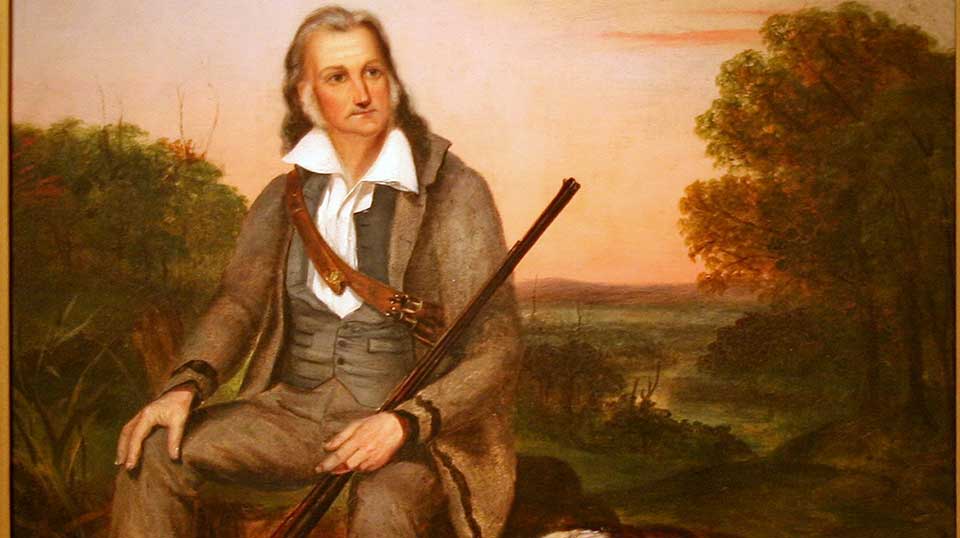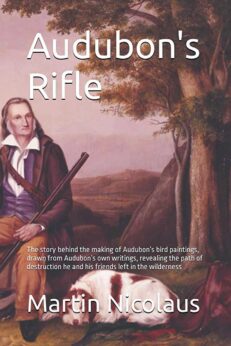
The image of John James Audubon is firmly lodged in our consciousness as a great, perhaps the greatest, American naturalist.
Audubon’s seminal Birds of America (1827-1839), a beautiful if daunting collection of 453 of his life-sized paintings of North American Birds, towers over the field, setting a standard for its day. The realism, detail, and color of these lustrous plates are a much-praised achievement, vastly advancing popular and scientific knowledge of ornithology.
As a self-taught savant, he was lavishly praised both during his life and even through to current times.
Audubon was the subject of many literary, musical, and even filmic paeans, including a 1952 movie starring Alan Ladd as his friend James Bowie. In 1969, Robert Penn Warren wrote the book length poem, “Audubon: A Vision.” Stephen Vincent Benet made him a hero in the children’s poetry collection, Book of Americans.
Parks, zoos, streets, schools, and bird sanctuaries carry his name and the perceived spirit of Audubonism.
In his name, Audubon societies were founded to protect birds, particularly from hunters. The organizations proliferated in the late nineteenth and twentieth centuries. Under this banner, wildlife conservation and protection of habitats were advanced. Their work included books, promotional pamphlets, film, and educational activities.
But even Audubon could not escape the recent re-assessments of historical figures found to have engaged in reprehensible behaviors no longer tolerated among our past heroes.
Martin Nicolaus—lawyer, naturalist, and head of Berkeley’s Cesar Chavez Park Conservancy—has done an admirable service sorting through Audubon’s checkered career and production. Nicolaus has marshaled incontrovertible evidence that in many ways Audubon was, as critics characterized him, an ornithological fraud who had great contempt for his subjects.
Nicolaus’ new book, Audubon’s Rifle, is an extraordinarily well-documented look beyond the beautiful paintings. This painful assessment of Audubon’s actions, behavior, methods, and ideas is a stark reminder that a keen eye is needed to view yesterday’s icons in today’s context.
Audubon, for instance, championed the cause of white supremacy. He bought, owned, and sold slaves. He was critical of abolitionists, and they excoriated him. Despite professing to admire Native Americans, he dug up Mexican skulls in a fervent effort to prove the superiority of Caucasians to other races, particularly those originating in Africa.
Audubon’s good friends John Townsend and John Bachman were prominent advocates of slavery. Bachman, who collaborated with Audubon to produce Viviparous Quadrupeds of North America, the successor to Birds of America, proclaimed that Black people were “inferior to Caucasians in intellect” and incapable of self-government.
A leader and pastor in the Lutheran Church for 56 years, Bachman argued that “our defense of slavery is contained in the Holy Scriptures.” These relationships certainly give credence to the old maxim: Birds of a feather flock together.
 The most famous naturalist in American history was no more considerate to the subjects of his life’s work than he was to “inferior races.” As author Nicolaus shows, Audubon killed birds for pleasure, amusement, and target practice.
The most famous naturalist in American history was no more considerate to the subjects of his life’s work than he was to “inferior races.” As author Nicolaus shows, Audubon killed birds for pleasure, amusement, and target practice.
He shot more birds than he actually painted. He killed recklessly, leaving injured birds to suffer and die, was unmoved by birds’ death agonies, exploited birds’ compassion for one another, and knowingly killed rare endangered species.
His methods were often sloppy, disrupting large tracts of natural habitat without considering the effects. He had trees chopped down to get at nests which he unnecessarily destroyed, killing brooding birds, hatchlings, fledglings, and stealing eggs. He actually promoted widespread killings by his followers as well, teaching others the most effective means of killing, whether close or long range.
This same careless, cruel approach to animals characterized much of his “scholarly” work. It was well-documented, even at the time Birds of America was written, that Audubon had falsified and fabricated personal as well as scientific data. He seems to have routinely plagiarized, published fraudulent data and images, and manipulated his records. His outrageous claims, including discovering new species, date from early in his career.
There is a lesson to be learned from Audubon’s life and work. But, thanks to true naturalists like Martin Nicolaus, it may not be the lesson that Audubon professed to disseminate!
Audubon’s Rifle
By Martin Nicolaus
Independently published; 2023; 104 pp.
We hope you appreciated this article. At People’s World, we believe news and information should be free and accessible to all, but we need your help. Our journalism is free of corporate influence and paywalls because we are totally reader-supported. Only you, our readers and supporters, make this possible. If you enjoy reading People’s World and the stories we bring you, please support our work by donating or becoming a monthly sustainer today. Thank you!












Comments